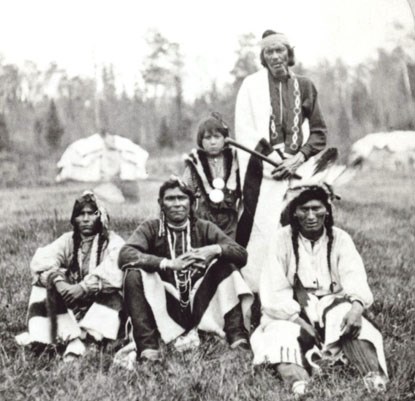Last updated: December 30, 2020
Article
Home of the Ojibwe

Home of the Ojibwe
This area named the Apostle Islands is home for some of the Ojibwe people who live throughout the Great Lakes. According to their written and oral history, the Ojibwe were the original inhabitants of this area. In order to gain the materials they needed to survive, they traveled throughout the islands with their main village being Madeline Island, which is known as Moningwunakauning: "Home of the yellow breasted woodpecker."
Throughout the four seasons the resources here sustained the Ojibwe for many years. From Lake Superior they would obtain fish year-round. In the fall they would harvest game and gather wild rice. In late winter they would tap the maple trees for their sap which was boiled into sugar. When the blossoms began to show, plants such as leeks, march marigold, and fiddleheads were used for food. Wintergreen, Labrador tea, and sweet flag were some plants that were used medicinally. The bark from the white birch was used to make wigwams, storage containers, and canoes. When summer came, berries such as strawberries, raspberries, and blueberries were gathered. Franklin Basina, and Ojibwe elder had once said, "When I was young those blueberries hung like grapes on those islands. I can only imagine what they used to be like before the other settlers came." Enough of these once plentiful resources were taken by the Ojibwe to carry them throughout the seasons.
The Ojibwe had great respect for the land and all that it had to offer. Nothing was taken without something given in return. Offerings of food and tobacco (made from red willow) were made to the spirits. When the life of an animal was taken the whole body was used, not letting anything go to waste. The Ojibwe also had great respect for their people, especially the elders. They always made sure the old ones were cared for before anyone else.
The Ojibwe once traveled throughout this area without boundaries until the 1800s when their lives began to change drastically. At that time the United States government negotiated a series of treaties with the Ojibwe which established reservations where many Ojibwe resite today. The treaties lessened the area where the Ojibwe could harvest, which in turn created hardships. Confined hunting and gathering depleted the resources the Ojibwe could rely upon.
The creation of the Apostle Islands National Lakeshore in 1970 greatly affected the natural and cultural resources of the area. The National Park Service is helping to preserve and restore some of the area that has been impacted over the years.
The Ojibwe today are working hard to bring back the knowledge that is needed in order to survive on this land. There is a great deal to be learned by everyone about the resources around us, at the stories that go with them. Ron Geyshick, and Ojibwe elder of Lac La Croix, Canada, said, "We need to respect and learn from these things around us. They teach us that everything struggles, deer, eagles, even the smallest andt Just watch them for a while. That's why we need to work together and live with the world around us. Have respect for these things that are sacred."
